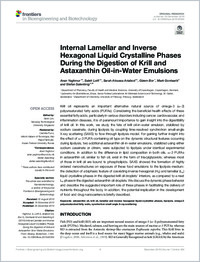Internal lamellar and inverse hexagonal liquid crystalline phases during the digestion of krill and astaxanthin oil-in-water emulsions
- Yaghmur, Anan Department of Pharmacy, Faculty of Health and Medical Sciences, University of Copenhagen, Denmark
- Lotfi, Saleh Department of Pharmacy, Faculty of Health and Medical Sciences, University of Copenhagen, Denmark
- Ariabod, Sarah Atoussa Department of Pharmacy, Faculty of Health and Medical Sciences, University of Copenhagen, Denmark
- Bor, Gizem Department of Pharmacy, Faculty of Health and Medical Sciences, University of Copenhagen, Denmark
- Gontsarik, Mark Laboratory for Biointerfaces, Empa, Swiss Federal Laboratories for Materials Science and Technology, St. Gallen, Switzerland
- Salentinig, Stefan Laboratory for Biointerfaces, Empa, Swiss Federal Laboratories for Materials Science and Technology, St. Gallen, Switzerland - Department of Chemistry, University of Fribourg, Switzerland
- 05.12.2019
Published in:
- Frontiers in Bioengineering and Biotechnology. - 2019, vol. 7, p. 384
English
Krill oil represents an important alternative natural source of omega-3 (ω-3) polyunsaturated fatty acids (PUFAs). Considering the beneficial health effects of these essential fatty acids, particularly in various disorders including cancer, cardiovascular, and inflammation diseases, it is of paramount importance to gain insight into the digestibility of krill oil. In this work, we study the fate of krill oil-in-water emulsion, stabilized by sodium caseinate, during lipolysis by coupling time-resolved synchrotron small-angle X-ray scattering (SAXS) to flow-through lipolysis model. For gaining further insight into the effect of ω-3 PUFA-containing oil type on the dynamic structural features occurring during lipolysis, two additional astaxanthin oil-in-water emulsions, stabilized using either sodium caseinate or citrem, were subjected to lipolysis under identical experimental conditions. In addition to the difference in lipid composition in both oils, ω-3 PUFAs in astaxanthin oil, similar to fish oil, exist in the form of triacylglycerols; whereas most of those in krill oil are bound to phospholipids. SAXS showed the formation of highly ordered nanostructures on exposure of these food emulsions to the lipolysis medium: the detection of a biphasic feature of coexisting inverse hexagonal (H2) and lamellar (Lα) liquid crystalline phases in the digested krill oil droplets' interiors, as compared to a neat Lα phase in the digested astaxanthin oil droplets. We discuss the dynamic phase behavior and describe the suggested important role of these phases in facilitating the delivery of nutrients throughout the body. In addition, the potential implication in the development of food and drug nanocarriers is briefly described.
- Faculty
- Faculté des sciences et de médecine
- Department
- Département de Chimie
- Language
-
- English
- Classification
- Chemistry
- License
-
License undefined
- Identifiers
-
- RERO DOC 327955
- DOI 10.3389/fbioe.2019.00384
- Persistent URL
- https://folia.unifr.ch/unifr/documents/308277
Statistics
Document views: 106
File downloads:
- pdf: 205
